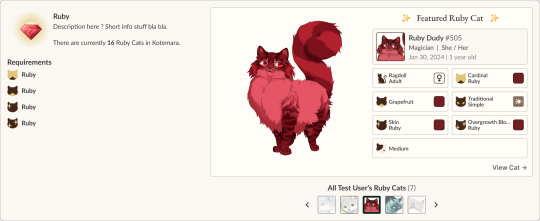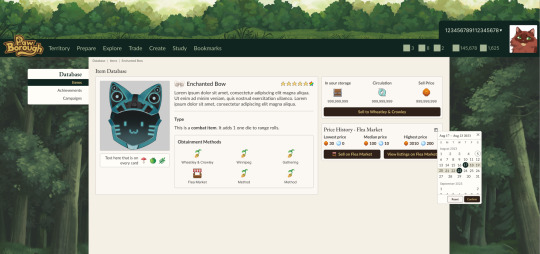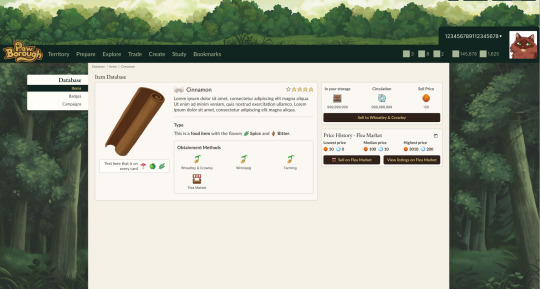#Database QA
Explore tagged Tumblr posts
Text
#Performance Testing#Security Testing#Load Testing#Software Optimization#Application Security#QA Performance#Cybersecurity Testing#Stress Testing#Mobile App Testing#Android Testing#iOS App Testing#Cross-Device Testing#Mobile QA#Mobile Automation Testing#App Performance Testing#Real Device Testing#Functional Testing#Software QA#Feature Validation#System Testing#Manual Testing#Automated Functional Testing#End-to-End Testing#Black Box Testing#ETL Testing#Data Validation#Data Warehouse Testing#BI Testing#Database QA#Data Quality Checks
0 notes
Text
February Check In

Hello, all!
Closed Beta's been open for nearly two weeks now and we’ve been busy at work, and excited to share with everyone some of our progress!
First, let’s look at some art!
Gilded Helm Recolors
We are currently working on the Gilded Helm's recolors, here are some previews!

Recolors by Emma.
New icons
We’ve been busy with icons!
Take a look at the renderings for our eye type and eye palette metamorphic items—lenses and prisms!
We also have the white marbles ready, which allow you to adjust the white coverage of your cats.
Moreover, we’ve created icons for our various shufflestones, which change a cat’s colors to completely random ones or to colors within a specific range.
Last but not least, we have several new food and supply icons ready!




Eye prisms, Shufflestones and marbles by Hydde. Food and supply items by Remmie, Tybaxel, and Nik.
New decor
We also made some progress on decor!

WIP roundable by Remmie and Giulia.
Development Check In
See the initial UIs for our in-development item database and achievement system for archetypes!
Archetypes, as introduced in our January update, are a specific combination of traits which, when fulfilled, mark the cat’s profile with a badge and reward the user as an achievement fulfillment. Below are the initial UI for the achievement part of this mechanic.


Browse through all available items in the game with our item database. Filter by category, rarity, color, or obtainment method to find exactly what you're looking for. Whether it's food, supplies, or metamorphics, everything is at your pawtips!



How is Beta going?
We’ve had a great time with Beta! Over 1100 users signed up!
While we did have server issues, we opted for optional maintenance downtimes that lasted between 1 to 5 minutes each to implement solutions. But the server did not and never did crash, which we are very happy about.
Halfway into the first week, we found a way to optimize, and since then the server has only had issues when we deploy fixes, which is expected during the application’s infancy. As we grow, deployments won't have these consequences, and patches will come out in big batches rather than small deployments. But it works for now as we make steady progress.
We do really enjoy this environment of testing. The amount of QA we get from the test is huge in helping us crack down on issues, and it's monumental in us improving the application. For the first two weeks of Beta, we did a lot of straight grinding to whittle down on the biggest issues, and we're very excited to get back to this pace. The energy has been a blast and a half, and we're happy with the progress we're making.
As we planned, we're doing less in the next two weeks before March. Our developers are taking a brief reprieve, and we’ll be making small updates in the meantime, but not nearly as frequent as the first two weeks of the test.
Myself (Blue) also needs a few days of rest, and I greatly appreciate the patience with our planned catnap.
But Beta has been fun as we make progress. That's a huge uplifter! There are a lot of ways in which development can feel thankless, demoralizing, or frustrating for the team. But the engagement from users and the community's joviality has lifted our spirits significantly. It’s great to feel so excited to keep working!
And the feedback has been juicy! There is a lot of very thoughtful criticism that has been sent for us to really sink our teeth into. We couldn't ask for anything better. This dedication will help us improve the application, and we love the time and energy put into feedback tickets. We care a lot about them, and value how much a user must care to send them.
Our projection of running through the summer is holding true based on our progress. We expect to see a very different application by the end of Closed Beta, and one which we’ll listen to the community on with how it's feeling. As we promised, we will not be moving into Open Beta until it feels good and we’ve gotten through our list of update priorities.
The biggest thing we've learned since the Closed Beta launch is to be more proactive and prepared with our communication. We apologize for the ways we have fumbled in making sure information is readily accessible, sensible, and concentrated, and for not adequately relaying both our intentions and easy instructions for users. We have learned, and we take responsibility for the initial frustration. We deserved the criticism. Thank you for expressing your concerns to us, and we'll employ everything we have learned going forward.
To summarize: We shared decors, Gilded helm recoloring, icons, item database and closed Beta update.
What to expect next month: Further asset and development updates. Check-ins for how closed Beta will be going.
#paw borough#pet site#virtual pet#indie game#pet sim#petsite#development update#pawborough#art update#kickstarter update#closed beta#beta test
33 notes
·
View notes
Text
ok personal grievance time.
my company—my parent-company really, because they acquired us several years ago as part of an identity crisis driven strategy but never really integrated us meaningfully so we’ve continued to function independently like the dumb little startup we were—just fired my boss and it is the stupidest, most careless decision I’ve ever…
it’s like they took inspiration from DOGE. just widespread mass firings of people in management positions without any consideration for their actual roles and importance.
this guy was not just the manager of my 3-person-software team—he was our company’s sole sys admin, our software architect, our database manager, our server manager, our go-to general IT person. none of us know how to do half the shit he does, or even what it is. what the FUCK are we going to do without him.
it is now just me and the QA guy and the 20-something junior developer we hired last year to replace our old head developer who quit, and we are going to just limp on for as long as we can, I guess, but literally what the fuck
… and my partner is suddenly back in the office full time for HIS job (because DOGE) when he’d previously been at home, and we just had this baby thinking we knew what our lives looked like and what our jobs looked like but yeah idk I am very checked out at work rn bc. baby. etc. uhh but if I don’t figure out how to suddenly do all these new responsibilities, our app will just stop functioning and our whole company will just be completely screwed.
and our boss is training us (purely because he’s just a good guy) and making sure we have access to various things and adding documentation but it’s so much and some of these platforms are eol in like 2 years and we’ll have to reconfigure everything somehow ahhh fuck
anyway.
I really can’t get over how unbelievably stupid it was to fire him. I would’ve said he was one of 3, maybe 4 people that this company literally couldn’t function without. And they just. Lol.
11 notes
·
View notes
Text
That post from like a month ago (I was planning to write this the day after and then immediately forgot and this has been in drafts since lol) about web devs not having some basic knowledge of the web has been stuck in my brain for a while because they are correct as I said in the notes but it's the landscape of web dev right now that's causing it and I don't see it stopping anytime soon.
I've been a professional Front End Dev for just over 7 years at this point (now a UX Dev working on a design system), and while I have a good chunk of experience under my belt, I've gotten to the point where I realize just how much shit I do not know and it's a LOOOOT.
The current landscape of web dev is that most projects and products are robust web apps that, in the absolute best case scenario, are gonna require, at minimum:
User experience research and work (UX)
User interface design (UI)
Front end with accessibility and mobile responsiveness (I am here)
Front end interactions and state management (JS engineers)
Backend database and API work
Backend infrastructure work (including setting up the dev and QA test environments)
QA testing
Developer experience to make sure devs/engineers are working efficiently with the tools they have
I'm sure I've missed some roles here, but you can see why people end up specializing when they work on bigger projects and products. The web is so unbelievably JavaScript heavy nowadays that all these specializations are Kind Of Required™, but that's absolute best case scenario. A lot of companies simply do not have the budget (or desire) to fill all these roles. So then you have a bunch of people who are kinda okay to mediocre at multiple of these things instead focusing on being good at one or two things. And then put in timeline requirements. AND THEN you have some companies who have different philosophies on how to build their core product: some are very UX focused and will put time into making sure that's present, others are not and will not care about UX in the slightest and thus those roles may not exist there at all. And...well things aren't going to be as quality as you expect when you consider all of those points.
The web is full of applications now that require a lot more expertise in different fields than just a basic static site with no data. That's not to say static sites don't exist or have no place anymore, tho. But this is where we are. It sucks.
#web#web dev#web development#front end development#back end development#ui design#ux design#html#CSS#JavaScript#career
10 notes
·
View notes
Text
Mobile App Development Services
Xtech Global specializes in creating high-performance mobile apps tailored to your business needs. Our expert developers build intuitive, scalable, and secure applications for iOS, Android, and cross-platform solutions. From UI/UX design to development and deployment, we ensure seamless user experiences and innovative functionality. Elevate your brand with a custom mobile app.

We deliver top-notch mobile app development solutions that are innovative, secure, and user-friendly. Whether it's iOS, Android, or cross-platform, our team crafts custom mobile apps tailored to your business goals. From concept to launch, we ensure seamless integration, robust functionality, and a superior user experience. Partner with us to transform your ideas into a powerful mobile apps.
Xtec Global offers comprehensive mobile app development services designed to meet your business needs. Our services here
Custom App Development: Tailored solutions for iOS, Android, and cross-platform apps that align with your business objectives.
UI/UX Design: Intuitive and engaging design ensuring a seamless user experience.
App Testing & QA: Rigorous testing to ensure functionality, security, and performance.
App Maintenance & Support: Ongoing updates, enhancements, and support to keep your app running smoothly.
App Integration: Smooth integration with existing systems, APIs, and databases for enhanced functionality.
3 notes
·
View notes
Note
#you guys don't know how software development works and it Pains Me
Could you expand on that?
I think the post sums it up well, that there are physical servers that need to host the platform and that costs money so there's truly no way to have a totally free website (that's why AO3 has fundraising drives, because the alternative is ads and nobody wants that on the Fandom Porn Site).
But also in the recent announcements about restructuring and large parts of the Tumblr team being reassigned to other teams within Automattic and Tumblr essentially being left with a skeleton crew is... not great? Like everyone is celebrating the fact that Tumblr Live is probably going to die soon and ignoring the part that they also won't be shipping many if any new features but instead focusing on the ones they have. And when that part is acknowledged the reaction seems to be that they're gonna fix a bunch of shit and like... they probably aren't.
Development is slow and it requires people and direction. I don't know the details of what staff currently looks like or who's going where but in my experience, "we're focusing on improving the features we have" means "whoever is left will be focused on keeping the lights on." Like, maintaining vital infrastructure and maybe fixing bugs here and there if they have the capacity for it.
Plus not having shiny new features as often if at all makes it really hard to drive new users to the platform, and that makes it less enticing for investors and/or advertisers.
I work for a SaaS company with a significantly smaller userbase than a typical social media site would have, even a relatively underused one like Tumblr (bc we're B2B so our customers are other businesses in a niche-ish field) and just one of our platforms has two distinct product teams, with each team consisting of a product manager, a designer, a handful of developers and a QA team, and that doesn't include the site reliability team who keep the whole thing running and solve database and server issues.
And it'll be hard to attract or retain top talent in any of these roles if your company just isn't putting the resources into the platform.
It takes a lot of people to keep a website functional, and I don't want to be doom and gloom because it might all be fine, at least for the foreseeable future, but it takes a lot of people to keep a software platform running.
I'm just glad it seems like no one at Tumblr is actually losing their jobs at this point.
And lbr I'm still gonna be here til the wheels fall off.
19 notes
·
View notes
Text
So, here I am, still humming “Angel of Mine”. Because I just spent the last three days working on databases, QA data, graphics and other not fun stuff for a meeting, I decided to highlight lyrics from the song...
I looked at you, lookin' at me
Now I know why they say the best things are free

Nothing means more to me than what we share
No one in this whole world can ever compare

Last night the way you moved is still on my mind
Angel of mine

I'll never knew I could feel each moment
As if it were new

I only share it with you

(You, you, you, you)

When I first saw you, I already knew

There was something inside of you

How you changed my world, you'll never know
I'm different now, you helped me grow

I looked at you, lookin' at me

Now I know why they say the best things are free
Checkin' for you, [girl] you're right on time

Angel of mine

#yes I made a hard copy print out of a fanvid#judge me idc#I suck at patience so learning video editing ain’t happening#is this a fanvid script#I guess#angel of mine by Monica is a treasure of a song#sydney adamu#carmen berzatto#Carmy is straight up in love so hard and so true that he doesn’t even make a fuss cuz loving Sydney is natural
3 notes
·
View notes
Text
How Bharathi Degree College Prepares You for Tech Jobs
A Launchpad for Digital Careers
As India cements its status as the next global tech powerhouse, the demand for job-ready tech professionals has surged across sectors. Companies today are not only scouting for coders or analysts—they’re investing in problem-solvers, innovators, and digitally fluent professionals. In the midst of this transformation, Bharathi Degree College, widely recognized as the best degree college in Warangal, has taken bold steps to position its students at the forefront of the tech job market.
Whether you're a student, a newlywed couple mapping your future, or an entrepreneur seeking to upskill your team, this 2500-word article reveals how Bharathi Degree College blends curriculum, mentorship, and digital innovation to fuel real-world tech careers.Why Tech Jobs Matter in Today’s Economy
India’s IT sector is projected to grow to $350 billion by 2026 (NASSCOM), with rising employment in:
Software Development & App Engineering
Data Science, AI, and Machine Learning
Cloud Computing & DevOps
Cybersecurity and Digital Infrastructure
Just as wedding photography in India has transitioned from static studio shoots to cinematic drone-based storytelling, the tech job landscape now demands storytelling through code, data, and scalable systems.Bharathi Degree College: Your Gateway to a Tech-Driven Future 1. Tech-Infused Curriculum
Bharathi Degree College’s syllabus is regularly updated to meet the needs of the ever-changing tech world:
Core Programming: Python, Java, C++, and JavaScript
Database & Cloud Systems: MySQL, MongoDB, AWS Fundamentals
AI/ML Basics: Algorithms, Neural Networks, TensorFlow foundations
Web & App Development: Full-stack architecture, UI/UX design
DevOps Tools: Git, Docker, Kubernetes, Jenkins (Introductory modules)
2. Skill-Centric Learning Framework
Weekly coding labs with real-world programming challenges
Annual hackathons judged by tech professionals
Open-source contribution sprints and GitHub portfolio building
Each component encourages hands-on mastery, collaborative coding, and adaptive thinking.Faculty That Bridges Theory with Tech Reality
Bharathi’s tech faculty consists of:
Certified professionals in AWS, Azure, and Google Cloud
Industry veterans with live project experience
Research scholars in data science and cybersecurity
They guide students not only in academics but in building practical tech profiles, much like a seasoned wedding photographer framing a couple’s love story with flair and precision.Industry Engagement and Internships
Bharathi Degree College creates an ecosystem of employability:
Corporate tie-ups with IT companies for virtual internships
Live project mentoring from real startup challenges
Tech-talks by engineers, product managers, and entrepreneurs
These bridges expose students to how code, data, and digital tools solve business problems.Specialized Tracks for Career Customization
Students can customize their path:
AI and Machine Learning Track – Python + TensorFlow + AI mini-project
Web Development Track – HTML/CSS + JS + React + Deployment skills
Data Analytics Track – SQL + Excel + Python + Power BI
This modular structure mirrors industry expectations.Smart Labs & Digital Learning
Much like the post-production labs of India’s elite wedding photographers:
Coding labs are equipped with cloud-based environments
LMS platforms track learning progress
AR/VR tools used for visualizing data structures and algorithm logic
These enhancements make learning immersive and flexible.Alumni Outcomes: Real Stories, Real Jobs
Graduates from Bharathi Degree College have gone on to:
Join tech giants and startups as software engineers, QA testers, and data analysts
Crack national-level competitive coding platforms
Build freelance portfolios with live client projects
Their success stories are a testament to the college’s reputation as the best degree college in Warangal for tech-readiness.Testimonials
“My professor encouraged me to publish my GitHub work in interviews. That changed everything.”
“Hackathons taught me more than textbooks ever could.”
“From zero code knowledge to interning as a front-end developer—I owe that journey to the faculty.”
FAQs
Q1: What programming languages are taught? Python, C++, Java, JavaScript, and R are core to the tech program.
Q2: Does Bharathi Degree College provide placement assistance? Yes, through mock interviews, resume workshops, and corporate connects.
Q3: Are the tech courses aligned with current market demands? Absolutely. Courses are co-designed with industry input and follow NEP 2020 standards.
Q4: What’s unique about tech learning here? Hands-on project immersion, competitive coding, and real-time simulation labs.
Q5: How do students build their portfolios? Via GitHub repositories, blog publishing, internship reports, and live demo apps.Final Word: Building India’s Next Tech Leaders
For brides and grooms building digital lives, for business owners digitizing their firms, and for students aiming at global tech roles—Bharathi Degree College in Warangal offers the perfect launchpad.
Backed by smart faculty, cutting-edge curriculum, and a mentorship-first approach, the college ensures that students graduate not just with degrees—but with digital confidence.
In Warangal, a city steeped in history and brimming with educational promise, Bharathi Degree College stands as the best degree college in Warangal to shape tomorrow’s tech leaders.
0 notes
Text
Application Development Services: Building Smarter Solutions for the Digital Age
The digital landscape is evolving faster than ever before. Businesses need smart, reliable, and customized applications to meet the growing demands of users and stay competitive. This is where Application Development Services play a vital role.
From improving internal workflows to enhancing customer engagement, modern application development is no longer just a tech option—it’s a strategic necessity.
What Are Application Development Services?
Application Development Services refer to the process of designing, developing, testing, and deploying software applications tailored to your business needs. These services are offered by professional development companies that specialize in creating:
Mobile Applications for Android and iOS
Web Applications accessible across browsers
Cloud-based Apps that are scalable and cost-efficient
Enterprise Software for internal systems and productivity
Cross-platform Applications that work on multiple devices
These solutions are built using modern technologies and frameworks to ensure performance, reliability, and flexibility.
Why Are Application Development Services Important?
Here’s how these services make a significant impact on modern businesses:
1. Business-Specific Solutions
Custom apps are designed around your unique workflows, not generic processes.
2. Improved Customer Experience
Deliver smooth, responsive, and personalized user experiences to increase engagement and loyalty.
3. Increased Efficiency and Automation
Streamline operations and reduce manual work by automating everyday tasks through digital tools.
4. Seamless Integration
Integrate apps with your existing software or third-party tools for a unified system.
5. Future-Ready Platforms
Applications are built to evolve with your business and adapt to new technologies over time.
Key Components of Application Development Services
Requirement Analysis – Understanding business needs and user expectations
UI/UX Design – Crafting intuitive and attractive interfaces
Backend Development – Building the logic, databases, and APIs that power the app
Frontend Development – Creating interactive and responsive user-facing elements
Testing & QA – Ensuring quality, speed, and security before launch
Maintenance & Updates – Keeping your app updated and fully functional post-deployment
Who Can Benefit from Application Development Services?
These services are valuable for businesses across all sectors, such as:
Retail & eCommerce: Build feature-rich apps for seamless shopping
Healthcare: Develop patient portals, appointment systems, and telehealth apps
Finance: Create secure apps for banking, investments, and payments
Education: Offer virtual classrooms and learning management systems
Logistics: Track inventory, deliveries, and fleet operations in real time
Tips for Choosing the Right Development Partner
Look for Proven Experience – Check their portfolio and client reviews
Focus on Communication – A good partner keeps you involved throughout the process
Ensure Flexibility – Choose a team that can adapt to changes and feedback
Prioritize Post-Launch Support – Ongoing maintenance is key to long-term success
Conclusion
In today’s digital-first world, a well-designed application can set your business apart. With the help of expert Application Development Services, you can bring your ideas to life, solve complex problems, and build digital tools that support your growth and success.

0 notes
Text
What I'm hearing (unverified, take it with a grain of salt, but also I've worked on software that if it broke things I'd hear out about it on CNN, and this explanation is consistent with the controls and decision-making processes I've seen) is this isn't a code problem in the CrowdStrike product. Instead, CrowdStrike pushed an update to their virus detection database. The virus detection database now contained an entry that mistakenly flagged a key Windows file as a virus, and quarantined it. Windows, not having a very much needed file anymore, crashed hard. On boot, it continued to not have the file and continued to crash hard.
This failure mode makes sense to me because:
Why roll out the database definition on a Friday? Because leaving the devices vulnerable to viruses over the weekend is *also* a risky move.
Why didn't QA catch this obvious problem? I'm doubtful a full QA run happens on each update to the virus detection database, that's way too time consuming and expensive for something you want to be updating as frequently as a virus detection database.
The comparison I've heard is an auto-immune disease: the antivirus protection has identified the host as a virus, the antivirus will defeat the virus even if it kills/crashes the host.
(in before notes: none of this is to say it's not CrowdStrike's fault. But I can easily see this kinda thing happening at most large enterprises using industry best practices. Our teetering digital economy is an edifice of hubris and luck.)
idk if people on tumblr know about this but a cybersecurity software called crowdstrike just did what is probably the single biggest fuck up in any sector in the past 10 years. it's monumentally bad. literally the most horror-inducing nightmare scenario for a tech company.
some info, crowdstrike is essentially an antivirus software for enterprises. which means normal laypeople cant really get it, they're for businesses and organisations and important stuff.
so, on a friday evening (it of course wasnt friday everywhere but it was friday evening in oceania which is where it first started causing damage due to europe and na being asleep), crowdstrike pushed out an update to their windows users that caused a bug.
before i get into what the bug is, know that friday evening is the worst possible time to do this because people are going home. the weekend is starting. offices dont have people in them. this is just one of many perfectly placed failures in the rube goldburg machine of crowdstrike. there's a reason friday is called 'dont push to live friday' or more to the point 'dont fuck it up friday'
so, at 3pm at friday, an update comes rolling into crowdstrike users which is automatically implemented. this update immediately causes the computer to blue screen of death. very very bad. but it's not simply a 'you need to restart' crash, because the computer then gets stuck into a boot loop.
this is the worst possible thing because, in a boot loop state, a computer is never really able to get to a point where it can do anything. like download a fix. so there is nothing crowdstrike can do to remedy this death update anymore. it is now left to the end users.
it was pretty quickly identified what the problem was. you had to boot it in safe mode, and a very small file needed to be deleted. or you could just rename crowdstrike to something else so windows never attempts to use it.
it's a fairly easy fix in the grand scheme of things, but the issue is that it is effecting enterprises. which can have a looooot of computers. in many different locations. so an IT person would need to manually fix hundreds of computers, sometimes in whole other cities and perhaps even other countries if theyre big enough.
another fuck up crowdstrike did was they did not stagger the update, so they could catch any mistakes before they wrecked havoc. (and also how how HOW do you not catch this before deploying it. this isn't a code oopsie this is a complete failure of quality ensurance that probably permeates the whole company to not realise their update was an instant kill). they rolled it out to everyone of their clients in the world at the same time.
and this seems pretty hilarious on the surface. i was havin a good chuckle as eftpos went down in the store i was working at, chaos was definitely ensuring lmao. im in aus, and banking was literally down nationwide.
but then you start hearing about the entire country's planes being grounded because the airport's computers are bricked. and hospitals having no computers anymore. emergency call centres crashing. and you realised that, wow. crowdstrike just killed people probably. this is literally the worst thing possible for a company like this to do.
crowdstrike was kinda on the come up too, they were starting to become a big name in the tech world as a new face. but that has definitely vanished now. to fuck up at this many places, is almost extremely impressive. its hard to even think of a comparable fuckup.
a friday evening simultaneous rollout boot loop is a phrase that haunts IT people in their darkest hours. it's the monster that drags people down into the swamp. it's the big bag in the horror movie. it's the end of the road. and for crowdstrike, that reaper of souls just knocked on their doorstep.
114K notes
·
View notes
Text
Where Can You Find FDA Inspector Details and Inspection Patterns?

By a Compliance Expert
FDA inspections are never random. Every inspector has their own way of working, some focus more on documentation, others on CAPA systems, while some might dig deep into your lab practices.
If you're part of a quality assurance (QA), regulatory affairs, or compliance team, the biggest question before an inspection is:
What will the FDA inspector look at, and how can we be ready in advance?
The good news is: You can now find answers to that.
Thanks to tools like Atlas Compliance, you can access detailed data on FDA inspectors, their past inspection history, and their behavior patterns all in one place.
Why Knowing Inspector Behavior Matters
Let’s say you're told that a particular FDA officer is coming to inspect your facility.
Wouldn’t you want to know:
How many inspections they’ve done?
What they usually issue Form 483s for?
How long their average inspections last?
If they’ve issued many warning letters in your industry?
This kind of knowledge can help your team prepare much better and avoid unexpected surprises.
What Information Can You Find in Atlas?
Atlas is a regulatory intelligence platform that offers a detailed database of FDA inspections, inspectors, citations, and more. Here's how it helps:
1. Inspector Overview
You can see:
Inspector’s full name and contact details
Years of experience (e.g., active since 2008)
Total number of inspections they’ve done
Countries where they’ve audited (e.g., U.S., India, China, Vietnam)
Number of 483s and warning letters they’ve issued
This helps you understand how experienced the inspector is and how strict they might be.
2. Inspection History
This shows you:
Company names they inspected
Industry type (pharma, food, cosmetics, etc.)
Whether a Form 483 or Warning Letter was issued
Inspection classification (e.g., NAI, VAI, OAI)
Number of days spent on-site
This helps you understand what kind of issues this inspector usually finds and how long they typically inspect.
3. Citations and CFRs
You can also access the exact citations an inspector has used in past audits. For example, if an inspector often cites 21 CFR 211.192 (investigation of discrepancies), then you know to double-check your deviation records.
This allows your QA team to focus on high-risk areas before the inspection.
4. Co-Inspectors
Some FDA inspections involve more than one officer. Atlas shows you which inspectors often work together.
Knowing this helps you prepare for multi-inspector audits.
5. Download Documents
You can download real FDA documents such as:
Form 483s
Establishment Inspection Reports (EIRs)
Warning Letters
These documents are valuable for internal training, benchmarking, and root cause analysis.
6. Trend Analytics
Atlas shows charts and graphs for:
Number of inspections by year
How many times 483s were issued
Most common CFR citations
Inspection behavior trends
This helps you understand if the regulatory focus is shifting (for example, from CAPA to data integrity).
7. AI Copilot
This feature uses artificial intelligence to give smart suggestions:
Predicts what an inspector might focus on
Shows common risk areas based on past findings
Gives hints like “check CAPA” or “review batch records”
It’s like having an AI-based checklist customized for your inspector.
Real Example: Lesley Swanson
Lesley Swanson is a real FDA inspector. Using Atlas, we can learn:
She has completed 203 inspections
She has issued 80 Form 483s
7 warning letters were given based on her audits
She inspects in countries like the U.S., India, China, Peru, and more
Her average inspection lasts 5.29 days
Wouldn’t it be useful to know all this before she visits your facility?
How Atlas Helps Your QA & RA Teams
Here’s what teams can do using Atlas:
✔ Train staff using real inspection patterns ✔ Review citations before inspections ✔ Prepare documentation based on actual FDA trends ✔ Avoid repeated mistakes from past audits ✔ Save hours of manual research by using one dashboard
What’s Next for FDA Audit Prep?
Regulations are getting stricter. Inspectors are relying more on data. Inspections are now more remote, risk-based, and data-driven.
This means your prep also needs to be smarter, not just more paperwork, but better tools.
Atlas is not just a platform. It’s a strategic advantage.
You don’t need to guess what your next FDA inspector is going to look for. With Atlas, you can prepare based on facts, trends, and real inspection data.
Because when you know more, you risk less. Frequently Asked Questions
1. Why should I care about who my FDA inspector is?
Knowing your inspector helps you prepare better. Each inspector has patterns, some issue more 483s, some focus more on documentation. If you know what they usually look for, you can get ahead of the risk.
2. Can Atlas really show me the full inspection history of an FDA officer?
Yes. Atlas gives you details like the number of inspections an officer has done, how often they issue 483s or warning letters, how long their inspections usually last, and which countries they've worked in. It’s like getting a sneak peek before the real show begins.
3. How do I know what specific issues an inspector usually finds?
Atlas pulls citation data and shows what sections of the CFR (Code of Federal Regulations) the inspector often refers to. This helps you understand exactly what they flag most.
0 notes
Text
Quality Assurance in Roof Replacement Services
Introduction
When it comes to home improvement and maintenance, few tasks are as critical as roof replacement. A roof is not merely a protective cover for your home; it's an essential component that contributes to the structural integrity, energy efficiency, and overall aesthetic of your property. Quality assurance in roof replacement services ensures that these vital aspects are addressed effectively. Not only does it guarantee that the work meets regulatory standards, but it also provides homeowners peace of mind.
This article delves into various facets of quality assurance in roof replacement services, discussing best practices, choosing licensed roofing contractors, understanding roofing services offered, and the costs associated with different types of roofing jobs. By the time you finish reading this piece, you’ll be well-equipped to make informed decisions regarding your roofing needs.
Quality Assurance in Roof Replacement Services
Quality assurance (QA) in roof replacement services refers to the systematic process aimed at ensuring that all aspects of a roofing project meet specified requirements and standards. This encompasses everything from the selection of materials to the workmanship involved in installation and repairs.
The Importance of Quality Assurance
Why should homeowners care about quality assurance? Here are some compelling reasons:
Durability: A well-executed roof replacement job minimizes future repair costs and prolongs the lifespan of your roofing system. Safety: Poorly installed roofs may lead to dangerous conditions such as leaks or structural failures. Cost-effectiveness: Investing in quality now can save significant amounts down the line on repairs or replacements. Home Value: A high-quality roofing job enhances curb appeal and can boost property value.
In essence, quality assurance is not merely an optional feature; it's a necessity for anyone considering roof replacement services.
Choosing Licensed Roofing Contractors Why Licensing Matters
When hiring roofing contractors, one crucial aspect is whether they are licensed. Licensed roofing contractors have met specific criteria set forth by local authorities, which often involve proving their skills through examinations and demonstrating knowledge of building codes.
Benefits of Hiring Licensed Roofing Contractors Compliance with Regulations: Licensed contractors ensure that their work adheres to local building codes. Insurance Coverage: They usually carry liability insurance which protects you from potential damages during installation. How to Verify Contractor Licenses Check online databases provided by state licensing boards. Ask for copies of licenses directly from the contractor. Review customer testimonials focusing on previous projects. Finding Certified Roofing Contractors What Does Certification Mean?
Certified roofing contractors have https://www.southernroofingsystems.com/best-roofers-near-you-spanish-fort-alabama undergone additional training and passed exams specific to certain types of roofs or materials. This distinction often indicates advanced experti
0 notes
Text
Mobile App Development Company in Dubai | GCC Marketing
In the dynamic and digitally-forward business environment of the UAE, mobile applications have become critical tools for success. From startups to large enterprises, every business is looking for innovative mobile solutions to stay competitive and connect with customers on the go. A trusted mobile app development company in Dubai can turn your vision into a scalable, user-friendly application that drives real results.
Why Mobile Apps Are Essential for Business Growth
With the rapid growth of smartphone usage in the region, having a mobile app is no longer optional. Mobile apps help businesses to:
Deliver personalized customer experiences
Increase brand visibility and loyalty
Enable seamless communication and real-time updates
Boost sales and improve operational efficiency
Access customer insights through in-app analytics
For businesses in Dubai, where consumer expectations are high and innovation moves quickly, a professional app can offer a significant competitive advantage.
What to Expect from a Top Mobile App Development Company in Dubai
Partnering with a leading mobile app development company in Dubai means more than just hiring coders. You gain access to an experienced team that guides your project from idea to deployment — and beyond.
Here are the core services you can expect:
iOS and Android App Development: Native solutions tailored for platform-specific performance
Cross-Platform Development: Code once, deploy across both iOS and Android using technologies like Flutter or React Native
UI/UX Design: Creating visually appealing and user-centric app interfaces
Backend Development & API Integration: Building the logic, databases, and third-party connections that power your app
App Testing & QA: Ensuring your app works smoothly, securely, and bug-free across all devices
Post-Launch Support: Continuous updates, feature enhancements, and maintenance
Why Choose a Dubai-Based Development Partner?
Dubai is a global technology hub with access to some of the world’s best talent and infrastructure. A mobile app development company in Dubai understands the local market, user behavior, and industry trends, making it easier to create solutions tailored to both regional and global audiences.
Local developers also offer quicker communication, on-ground meetings, and cultural alignment — all critical for the success of your digital product.

Conclusion
If you're looking to build a mobile app that stands out in a crowded market, choosing the right mobile app development company in Dubai is essential. The right partner will offer strategic insight, technical expertise, and dedicated support — helping you launch a high-quality app that meets your business goals and exceeds user expectations.
#app development dubai#mobile app development dubai#app development companies in dubai#application development dubai#mobile app development company in uae#mobile app development company#app development companies in uae#mobile app development company in dubai
0 notes
Link
0 notes
Text
How Regression Testing Fits into the Software Development Life Cycle (SDLC)
Do you ever launched a new feature only to realize that an older one mysteriously broke? Yes — that’s exactly where regression testing comes in to save the day. Whether you’re a developer, QA analyst, product owner, or tech enthusiast trying to understand how the gears of software quality turn, this guide will walk you through the when, where, and why of regression testing within the Software Development Life Cycle (SDLC). Let’s break it down, step by step.

First, What Exactly Is Regression Testing?
In simple terms, regression testing ensures that new code changes don’t break anything that was previously working. It’s a repeatable process that retests existing functionality after updates, bug fixes, enhancements, or integrations. Think of it as a safety net. You're not just checking if the new feature works — you're confirming that everything else still works with it.
Understanding the Software Development Life Cycle: A Quick Refresher
Before we explore where regression testing fits in, let’s quickly recall the stages of a typical Software Development Life Cycle:
Requirement Gathering & Analysis
Design
Development (Coding)
Testing
Deployment
Maintenance
Regression testing doesn’t just sit in one stage — it weaves through multiple points, particularly from testing onward.
Regression Testing in Action: Stage by Stage
Requirement Gathering & Analysis: The Groundwork
At this early stage, regression testing isn’t directly involved yet — but your test planning begins here. If you’re a QA or project manager, ask yourself — "What parts of the app are most likely to be affected by future changes?"
Mapping dependencies early helps you identify key areas to include in your regression test suite later on.
Design: Thinking Ahead
When technical and UI/UX design is finalized, the QA team begins designing test cases — both for new features and critical existing features that might be impacted. Tools like TestRail or Zephyr come in handy here to organize regression scenarios alongside functional test cases.
Document modules with high change frequency — they’re prime candidates for ongoing regression coverage.
Development: Code, Merge, Repeat
During the development phase, regression testing quietly prepares in the background. Once code is committed:
Unit tests are run.
Continuous integration pipelines trigger automation scripts.
Regression test sets are prepared to run once new builds are ready.
If your team follows Agile or DevOps, regression tests are often run after every sprint or even nightly in CI/CD workflows.
Ask your development team: "Are we tagging high-risk components so we can test around them?" It actually saves time when selecting regression scope.
Testing: Regression Testing Comes to Life
Now comes the main stage for regression testing. When the new build hits the QA environment, regression testing begins in full swing. Here’s where you might use:
Manual regression testing for complex user flows
Automated regression testing for repetitive, high-priority test cases
Typical triggers for regression testing at this stage are new feature rollout, Bug fixes, Database changes, Code refactoring and Integrations with third-party APIs. The goal is, catch anything that breaks — before users do.
You may think like a user- “Does login still work? Can I still add to cart? Do emails still send?” That’s the mindset you need when selecting regression cases.
Deployment: Final Checks Before Go-Live
Before pushing the release to production, a final regression sweep is often performed on a staging environment. This is known as a pre-deployment regression check, and it’s crucial — especially for:
High-traffic apps
Payment gateways
Systems with sensitive data
Overlooking regression testing here is equivalent to neglecting a critical pre-launch checklist — it compromises the integrity of your entire release. Use automation here for speed, but keep a manual tester on standby for exploratory verification.
Maintenance: Regression Never Sleeps
Even after deployment, regression testing continues during:
Patch updates
Security fixes
Performance tuning
Here, automation works the most. Your regression suite evolves into a living asset — growing with your application. It’s common for teams to schedule weekly or nightly regression runs to ensure the app stays stable over time.
Ask your team: "Do we have a regression suite that auto-runs when we update our dependencies or libraries?" If not, now’s the time to start building one.
Building a Smart Regression Testing Strategy
Want to make regression testing really work for you? Focus on:
Test Prioritization
Not everything needs to be tested every time. Classify tests as:
Smoke (basic functionality)
Sanity (key flows)
Full Regression (deep testing across the app)
Automation
Automate repetitive tests with tools like:
Selenium
Cypress
TestNG
Playwright
These save time and boost consistency — especially in CI/CD setups.

Continuous Updates
Your regression suite should evolve with your app. Add new cases for every release, and remove obsolete ones. It all matters because, in this fast-moving digital world, you can’t afford uncertainty in software quality. A single untested change could mean:
Broken payment systems
Crashed mobile apps
Unhappy users
Bad reviews
With robust regression testing in your Software Development Life Cycle, you gain:
Confidence in code stability
Faster release cycles
Fewer hotfixes
Better user experience
Bottom Lines
Regression testing isn’t a one-off task. It’s a discipline, a mindset, and a guarantee that progress won’t come at the cost of performance. So, the next time your team moves forward — adding features, fixing bugs, deploying upgrades — don’t forget to look back. Because regression testing is what ensures your past victories aren’t undone by your next update.
At BriskWinIT Solutions, we specialize in delivering thorough, efficient, and scalable regression testing services personalized to your development lifecycle. Whether you're scaling fast or making incremental changes, we help ensure your software evolves — without breaking what matters. After all, progress without protection is just a chance — and BriskWinIT is here to make sure you never have to take that risk.
Over to You!
How does your team handle regression testing in your Software Development Life Cycle? Do you rely more on manual or automated methods? Have a favourite regression tool?
Drop your thoughts, experiences, or questions in the comments below. Let’s keep the quality conversation going. Contact us right away!
0 notes
Text
Logistics app development process in 2025: features, cost & roadmap to success
In 2025, real-time delivery tracking, AI, and inventory automation are no longer optional—they’re standard. Whether you're a startup or enterprise logistics firm, this guide breaks down everything you need to know to build a powerful logistics app that scales.
Why logistics is going digital
Logistics apps are solving key industry pain points like:
Lack of transparency in shipments
Poor communication between teams
Manual route planning
Inventory mismanagement
As eCommerce, global trade, and last-mile delivery continue to grow, businesses are under pressure to deliver faster, cheaper, and more accurately. That’s where digital logistics solutions step in, offering better visibility, efficiency, and customer satisfaction.
Growth of logistics tech in 2025
The logistics tech market is expected to cross $80 billion by 2026, driven by automation, AI, and real-time systems. Here's what’s pushing the growth in 2025:
Surge in eCommerce & D2C businesses
On-demand delivery culture (Zomato, Blinkit, Amazon)
Rise of EV logistics fleets
Focus on sustainability and green logistics
Market trends in logistics tech
Modern logistics apps aren’t just digital,they’re intelligent. These are the top technologies shaping the future:
AI & Machine Learning: For demand forecasting, route prediction, and delivery time estimation
IoT Sensors: For temperature tracking, vehicle health, and inventory status
GPS & Real-time Tracking: Enables live shipment updates
Blockchain: Secure and tamper-proof delivery records
Cloud Platforms: Scalable storage and low-latency systems
Step-by-Step logistics app development process
Building a logistics app isn’t just about coding. Here’s a roadmap to follow:
1. Market Research
Understand your user base,fleet managers, delivery agents, vendors, or end customers. Analyze competitors like Locus, Bringg, and Onfleet.
2. Choose App Type
Decide the app model:
B2B – For logistics companies or vendors
B2C – For direct customer deliveries
Hybrid – Mix of both
3. Feature Planning
Prioritize features based on user roles (Admin, Driver, Customer). Plan for MVP first, and scale later.
4. UI/UX Design
Design a clean, intuitive interface with easy access to route info, delivery status, and real-time notifications.
5. Tech Stack Selection
Pick a modern, scalable stack. (More below.)
6. Backend + Frontend Development
Your developers will build core features: login, map integration, shipment tracking, notifications, and dashboards.
7. QA Testing
Ensure your app works across devices, network conditions, and use cases. Test GPS, offline syncing, and driver communication.
8. Launch + Ongoing Support
Once deployed, continuously monitor app performance, update features, and gather user feedback.
Must-Have logistics app features
Here are essential features for a functional and competitive logistics app:
📍 Real-Time Tracking: GPS-based live location of fleets or parcels
📦 Inventory Management: Live stock updates across warehouses
🛣 Route Optimization: AI suggests fastest, traffic-free delivery paths
📤 Push Notifications: Alert drivers/customers on updates or delays
👨✈️ Driver Dashboard: Track earnings, trips, delivery success rate
📋 Delivery Proof: Upload signatures, photos, or QR code scans
💬 In-App Chat/Support: Seamless communication between drivers, admins, and customers
Technology stack suggestions
Here’s a modern stack you can consider for 2025:
Frontend: Flutter (for cross-platform), React Native (for high performance)
Backend: Node.js / Django / Laravel (based on your team expertise)
Database: Firebase, MongoDB, PostgreSQL
Maps & Navigation: Google Maps API, Mapbox, OpenStreetMap
Cloud: AWS, Google Cloud, Azure
Push Notifications: Firebase Cloud Messaging (FCM), OneSignal
Tips to choose the right development partner
Here’s how to ensure your logistics app is built for success:
Look for experience in transportation or supply chain apps
Check portfolio and client reviews
Ask about support, updates, and scalability
Ensure they can integrate AI and real-time systems
Choose a team that understands both tech and logistics business models
Conclusion :
Building a logistics app in 2025 is no longer just a tech project, it’s a business enabler. With real-time capabilities, optimized delivery, and enhanced transparency, a smart logistics app can drastically improve efficiency and customer experience.
Whether you’re a logistics startup, an eCommerce brand, or a delivery aggregator, now is the time to invest in digital logistics infrastructure.
#Logistics app development process#Logistics innovation trends#app development company#app developers#Travel#tranportation#logistics app development process#transport and logistics app development#fleet management app development#logistics app development company
0 notes